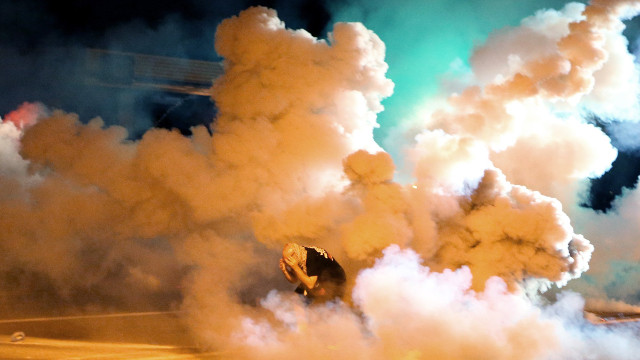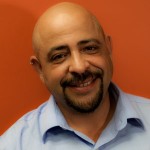
A protester takes shelter from smoke billowing around him Wednesday, Aug. 13, 2014, in Ferguson, Mo. Protests in the St. Louis suburb rocked by racial unrest since a white police officer shot an unarmed black teenager to death turned violent Wednesday night. (AP Photo/St. Louis Post-Dispatch, David Carson)
There have been five consecutive days of protests — followed by nights of civil unrest — in Ferguson, Missouri, a suburb of St. Louis with just over 20,000 residents, following the shooting death of 18-year-old Michael Brown by a police officer last Saturday. The events of the past week have focused the nation’s attention not only on what’s been happening in this small community, but also on tensions between police and communities of color, the policing of protests in the US since 9/11 and the militarization of even small-town police departments across the country.
Much has been written about these issues in the past days; here are some stories that we think are important for understanding what’s going on.
The shooting
There have been three shootings in Ferguson over the past five days, but so far police believe them to be unrelated. In two of those incidents, black men were killed by Ferguson police officers. The first of these incidents sparked outrage in the community — and nationwide.
Police say Michael Brown, who was described by neighbors as someone who kept to himself and was scheduled to begin community college this week, struggled with an officer, reached for his gun, and the officer responded with deadly force. Multiple witnesses dispute the account.
MSNBC’s Trymaine Lee interviewed Dorian Johnson, a close friend of Brown’s who was walking with him as the incident unfolded. He says that the officer shot down Brown “like a dog” while he was trying to surrender. His lawyer says that “he offered the police an opportunity to speak with Johnson, but they declined.” (Amanda Terkel of The Huffington Post reported via Twitter that police finally interviewed Johnson on August 13, five days after the shooting.) Two other eyewitnesses to the shooting offered similar accounts.
Anger over the shooting was heightened by witness accounts that Brown’s uncovered body was left lying in the street for several hours. The police department has also refused to name the officer responsible for the shooting, citing threats on social media. Police have also refused to release a preliminary autopsy on Brown’s body, or say how many bullets they retrieved. UPDATE, August 15: Police said that the officer involved in the shooting was a six-year veteran named Darren Wilson. They released an incident report for a nearby strong-arm robbery, implying that Brown was a suspect in the incident or at least fit the description of the suspect, but continue to withhold the report about the shooting itself.
The context
Tensions between communities of color and the police departments that serve them were already running high after the high-profile case of Eric Garner, an unarmed Staten Island man who died after NYPD officers allegedly placed him in an illegal chokehold while attempting to arrest him for illegally selling cigarettes. He was one of four unarmed black men killed by police in questionable circumstances over the past month. MoJo’s Josh Harkinson has the details of the other incidents.
Two-thirds of the citizens of Ferguson are African-American. Fifty of the town’s 53 police officers are white. Mark Peters and Ben Kesling report for The Wall Street Journal that racial tensions in the community have been simmering “for decades,” as the community underwent a significant demographic shift since 1970.
The St. Louis American offered a moving editorial about the recent history of a community that has “suffered decades of economic disinvestment, loss of manufacturing jobs and disruption by highway construction and airport expansion.” “White flight” added to the community’s demographic shift. At MSNBC, Zachary Roth explains that the police department’s lack of diversity isn’t unique — Ferguson’s local government is almost entirely white as well.
The protests
There have been large, mostly peaceful protests every day since Brown’s shooting. On Sunday night, a group of protesters looted several stores and burned down a convenience store. Matt Pearce of the Los Angeles Times has details of those incidents. Police officials also said that one of their helicopters had been fired upon during the unrest on Sunday night. On Tuesday, prosecutors announced the indictment of nine people for the looting; a local TV news station reports that more prosecutions may follow.
The policing
On Saturday, the St. Louis County police department reportedly arrived at the first vigil for Michael Brown in heavy body armor and riot control gear. By Thursday, there was as much or more media attention on the police department’s tactics as there was on the Brown shooting itself. That was in large part a result of several reporters and local politicians being arrested on Wednesday, as peaceful protesters were met with heavily-armed riot police who leveled their weapons at them and ordered them to disperse. Other journalists reported being blocked by police while trying to cover the events in Ferguson.
There are a number of accounts of what happened in Ferguson on Wednesday. Some notable reads are…
- “What I saw in Ferguson” — a first-person account of police filling the streets of the small community with tear gas “hours after the protests ended” by Jelani Cobb in New York magazine.
- “In Ferguson, Washington Post reporter Wesley Lowery gives account of his arrest“
- “Huffington Post Reporter Arrested In Ferguson” — an account of HuffPo senior Washington correspondent Ryan Reilly’s arrest.
- “The Most Outrageous Police Tactics In Ferguson” — A ThinkProgress roundup with many disturbing images.
- “RAW video of Al Jazeera America crews hit with tear gas” — Footage from KSDK of an Al Jazeera film crew being fired upon, and then police coming to disassemble their equipment.
Roy Greenslade reports for The Guardian that the two journalists detained overnight were released without charge after a call from a Los Angeles Times reporter to the chief of the Ferguson police, who appeared to be unaware of the arrests.
At The Washington Post’s Monkey Cage blog, Kim Yi Dionne looks at research showing that police respond differently to protestors according to their race. “When compared with other groups, African American protesters are more likely to draw police presence and… once police are present they are more likely to make arrests, use force and violence, and use force and violence in combination with arrests,” wrote political scientists Christian Davenport, David Armstrong and Sarah Soule in their study covering 15,000 “demonstration events” in the US. And Terrence McCoy reports that a paradox of tear gas is that its use on the battlefield is banned by treaty but it is commonly deployed to disperse crowds here at home.
And at The Daily Banter, Bob Cesca compares law enforcement’s response to the protests in Ferguson with its handling of the recent standoff at the Bundy Ranch in Nevada.
The militarization
The events of past days have brought the militarization of American police departments into stark relief — which may be a silver lining given that until now, as the ACLU noted in a report on the topic, “It has been allowed to happen in the absence of any meaningful public discussion.” A good primer on the process of militarization is Matthew Harwood’s “One Nation, Under SWAT,” at TomDispatch. And at The Intercept, Glenn Greenwald also covers some of the history, noting that militarization always disproportionately impacts communities of color. And Jesse Singal writes at New York magazine about what psychologists call “the weapons effect” — the tendency for weapons to alter behavior. Former Seattle police chief Norman Stamper, who presided over that city’s “Battle of Seattle” — heavy-handed responses to the 1999 WTO protests — spoke to Vox’s Amanda Taub about the problems with police militarization.
What’s next
The investigation into Michael Brown’s shooting is ongoing. Both the FBI and the Justice Department are also conducting probes into Brown’s death — with the latter looking at potential civil rights violations. Tensions between the community and police agencies may be keeping some potential witnesses from describing what they saw lat Saturday, according to various reports.
Carey Gillam reports for Reuters that the decision about whether to charge the officer under Missouri law will be made by Bob McCulloch, a veteran prosecutor. Colleagues say he’s a straight-shooter but local activists distrust him — and say that the childhood shooting death of his father, a policeman, by an African-American man makes him biased.
Protests are scheduled to continue in Ferguson. Governor Jay Nixon told reporters on Thursday that police would take a different approach to crowd control, and Jonathan Allen reports for Bloomberg that the St. Louis County police department is being removed from Ferguson. The New York Times reports that security will now be provided by the Missouri State Highway Patrol.
This is a developing story, and we’ll update it as necessary.


